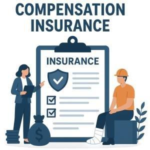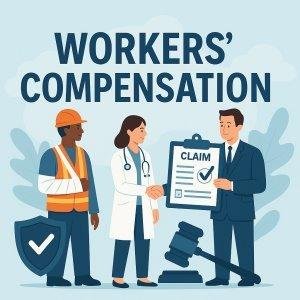
Employee Leasing Firm Workers’ Comp Rates 2024
September 17, 2025
Cannabis Dispensary Security Guards: Georgia Workers’ Comp Challenges & Solutions
September 17, 2025In the dynamic and often hazardous environment of construction sites,the role of security guards extends beyond traditional protective duties to encompass critical safety responsibilities. Given the elevated risks inherent in these settings-from heavy machinery to unpredictable site conditions-ensuring thorough workers’ compensation coverage is essential for both employers and employees. This article explores the unique challenges faced by construction site security guards, the importance of tailored workers’ compensation policies, and proactive strategies to mitigate risks, thereby safeguarding investment and workforce welfare in this high-stakes industry.
Table of Contents
- Construction Site Security Guard Hazards and Workers’ Compensation Implications
- Risk Assessment Strategies for Enhancing Site Security Personnel Safety
- Implementing Comprehensive Training Programs to mitigate Injury Claims
- Best Practices for Managing Workers’ Compensation Costs in Construction Security Roles
- Q&A
- The Way Forward
Construction Site Security Guard Hazards and Workers’ Compensation Implications
Security guards operating on construction sites face a unique set of hazards that substantially increase their risk of injury. Unlike traditional security roles, these guards frequently enough navigate uneven terrain, heavy machinery, and incomplete structures, making slips, trips, and falls frequent concerns. Additionally, exposure to hazardous materials, adverse weather conditions, and potential confrontations with trespassers or disgruntled workers intensifies the likelihood of accidents. Understanding these elevated risks is essential for crafting effective workers’ compensation policies that reflect the true dangers inherent in this environment.
Employers must implement rigorous safety protocols and specialized training programs tailored to mitigate these site-specific threats.Essential preventive measures include:
- Comprehensive hazard awareness and situational training
- Provision of personal protective equipment (PPE) suited for construction environments
- Regular site safety audits to identify and address emerging risks
- Clear communication channels between security personnel and construction management
Moreover, recognizing these factors enables more accurate workers’ comp classifications and premium calculations, ensuring guards receive appropriate coverage and support in case of injury. The table below summarizes common hazards alongside potential workers’ compensation considerations:
| Hazard Type | Risk level | Workers’ Comp Implication |
|---|---|---|
| Falls from uneven surfaces | High | Increased claim frequency, higher premiums |
| Equipment-related injuries | Moderate | Continuous safety training required |
| Exposure to hazardous substances | Moderate | Extended medical treatment coverage |
| Physical confrontations | Low to Moderate | Potential for serious injury claims |
Risk Assessment Strategies for Enhancing Site Security Personnel Safety
Conducting a thorough evaluation of site-specific hazards is crucial in mitigating risks for security personnel stationed at construction zones. This process requires a systematic approach that incorporates on-site observations, historical incident data analysis, and collaboration with both safety officers and site managers. Prioritizing risk factors such as equipment operation zones, night shifts, and unauthorized entry attempts enables the growth of tailored safety protocols.Incorporating technology like CCTV monitoring and wearable safety devices further enhances real-time risk detection and response capabilities, reducing the likelihood of injury or compensation claims.
Implementing a dynamic risk assessment framework involves continuous review and adjustment based on evolving site conditions. Key elements include:
- Regular hazard identification walkthroughs with security personnel
- Training programs focused on situational awareness and emergency response
- Clear communication channels for reporting risks promptly
- Routine audits supplemented by incident trend tracking
Below is a summary table categorizing common risks and recommended mitigation measures relevant to construction site security guards:
| risk Category | typical Hazards | Mitigation Strategies |
|---|---|---|
| Physical Threats | Unauthorized intrusions, altercations | Enhanced perimeter controls, conflict de-escalation training |
| Environmental Hazards | Uneven terrain, weather exposure | Proper footwear, weather-appropriate gear |
| Operational Risks | Heavy machinery proximity, restricted zones | Defined safe zones, constant communication with equipment operators |
Implementing Comprehensive Training Programs to Mitigate Injury Claims
Establishing a thorough training regimen is paramount in reducing the frequency and severity of injury claims among construction site security guards. These programs must be tailored to address the specific hazards attendant to construction environments, including proper handling of heavy equipment, fall prevention techniques, and emergency response protocols. Regular refresher courses ensure that guards remain vigilant and up-to-date with evolving safety standards and site-specific risks. Incorporating scenario-based drills and hands-on practice significantly enhances the retention of critical safety procedures.
Investing in comprehensive training not only improves individual guard safety but also bolsters overall site security management by fostering a culture of proactive risk mitigation. Key components to include are:
- Hazard recognition and reporting
- Incident documentation and communication
- Personal protective equipment (PPE) usage
- Conflict resolution and situational awareness
| Training Module | Focus Area | Duration |
|---|---|---|
| Site Hazard Identification | Risk Awareness | 2 hours |
| Emergency Procedures | Response & Evacuation | 3 hours |
| Personal Protective Equipment | Proper Use & Maintenance | 1.5 hours |
| Conflict Management | De-escalation Techniques | 2 hours |
Best Practices for Managing Workers’ Compensation Costs in Construction Security Roles
Effective management of workers’ compensation costs begins with a strategic approach to risk reduction and employee safety. Ensuring that security personnel are thoroughly trained in site-specific hazards can dramatically decrease the frequency and severity of workplace injuries. Emphasizing the use of personal protective equipment (PPE), adherence to safety protocols, and proactive communication channels allows for early identification and mitigation of potential threats. Consider implementing regular safety audits and incident reviews to continuously improve risk management processes and empower supervisors to enforce compliance consistently.
Financial oversight plays a pivotal role in controlling workers’ comp expenses,especially in the high-risk environment of construction security. Utilizing data analytics to track injury patterns and claim histories helps identify areas needing intervention, allowing management to allocate resources more effectively. Below is a concise table showcasing key cost-control tactics and their impact:
| Strategy | Primary Benefit | Expected Outcome |
|---|---|---|
| Targeted Safety Training | Minimizes accident frequency | Lower injury rates,reduced claims |
| Early Claims Reporting | Improves claim processing speed | Faster return-to-work,cost savings |
| Utilizing Return-to-work programs | Facilitates workforce homeostasis | Reduced compensation duration |
- Engage employees: foster a culture of safety through regular feedback and involvement.
- Partner with insurers: Collaborate to tailor coverage and gain insights on best risk control practices.
- Monitor subcontractor compliance: Ensure all security staff across the site meet safety standards.
Q&A
Q&A: construction Site Security Guard Workers’ Comp - Controlling Elevated Risks
Q1: Why do construction site security guards face elevated workers’ compensation risks compared to other sectors?
A1: Construction sites are inherently hazardous environments due to heavy machinery, ongoing construction activities, uneven terrain, and exposure to weather elements. Security guards on these sites are often required to navigate these risks while performing their duties,increasing their likelihood of workplace injuries such as slips,trips,falls,and incidents involving equipment.
Q2: What types of injuries are most common for construction site security guards?
A2: The most frequent injuries include musculoskeletal strains from physical exertion, falls from heights or uneven surfaces, cuts and abrasions from sharp objects or debris, and injuries related to vehicle or equipment accidents. Exposure to hazardous materials and environmental conditions can also lead to long-term health issues.
Q3: How does workers’ compensation insurance address these elevated risks for security guards on construction sites?
A3: Workers’ compensation insurance provides coverage for medical expenses, rehabilitation costs, and lost wages resulting from work-related injuries or illnesses. Given the higher risk profile on construction sites, premiums for security guards might potentially be adjusted accordingly. Insurers also emphasize risk management and safety protocols to mitigate claim frequency and severity.
Q4: What proactive measures can construction companies take to control workers’ comp costs for site security?
A4: Companies can implement comprehensive safety training tailored to site security guards, enforce strict adherence to personal protective equipment (PPE) protocols, and conduct regular site hazard assessments. Additionally, integrating security guards into broader safety programs ensures cohesive risk management and early identification of potential hazards.
Q5: How crucial is communication between security personnel and construction management in reducing workers’ comp incidents?
A5: Effective communication is critical. It ensures that security guards are informed about daily site conditions, ongoing construction activities, and any new hazards. Timely sharing of safety information allows guards to adjust their routines accordingly, reducing exposure to risks and preventing incidents.
Q6: Are there technology solutions that can assist in minimizing workers’ compensation claims for construction site security guards?
A6: Yes, technology such as wearable devices can monitor guards’ physical activity and environmental conditions, providing real-time alerts for potential risks. site monitoring systems and mobile safety apps facilitate rapid reporting and response to hazardous situations, enhancing overall safety and reducing injury rates.
Q7: What role does post-incident management play in controlling workers’ compensation costs?
A7: Prompt and effective post-incident management, including immediate medical attention, thorough investigation, and implementation of corrective actions, helps reduce the severity of injuries and prevents recurrence. Early return-to-work programs and rehabilitation support are also vital in minimizing downtime and related expenses.
Q8: How can security firms specializing in construction sites differentiate themselves through workers’ compensation risk management?
A8: Firms that invest in rigorous training, maintain robust safety protocols, and collaborate closely with construction clients to address site-specific risks can significantly reduce injury rates. demonstrating a commitment to proactive risk mitigation not only lowers workers’ comp claims but also enhances reputation and client trust.
This Q&A provides a comprehensive overview of the unique challenges and strategies related to workers’ compensation for construction site security guards, emphasizing risk control and business continuity.
The Way Forward
managing the elevated risks associated with construction site security guard workers’ compensation requires a proactive and strategic approach. By implementing comprehensive safety protocols, investing in specialized training, and fostering clear communication channels, construction firms can not only mitigate potential hazards but also reduce the financial impact of workplace injuries. Prioritizing these measures ensures a safer work environment for security personnel, ultimately protecting both the workforce and the association’s bottom line.As the construction industry continues to evolve, maintaining vigilant attention to workers’ comp considerations remains essential for sustained operational success.
“This content was generated with the assistance of artificial intelligence. While we strive for accuracy, AI-generated content may not always reflect the most current information or professional advice. Users are encouraged to independently verify critical information and, where appropriate, consult with qualified professionals, lawyers, state statutes and regulations & NCCI rules & manuals before making decisions based on this content.

